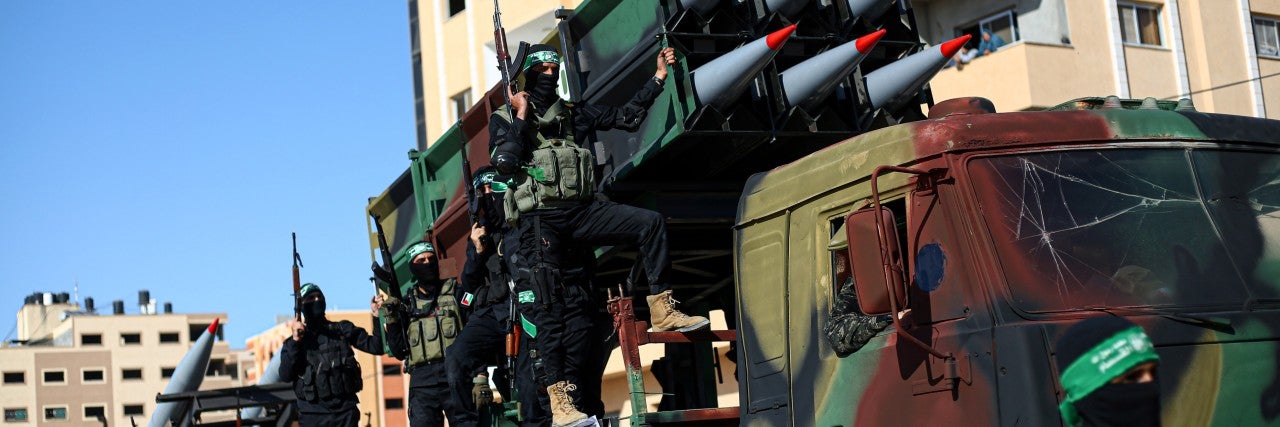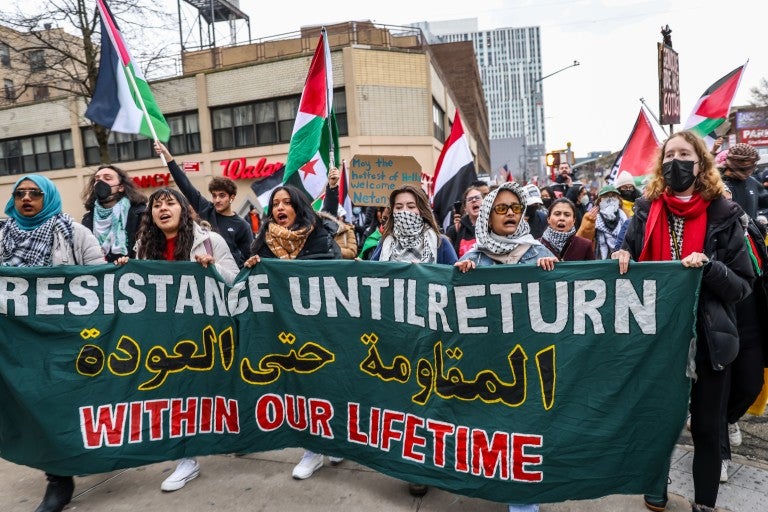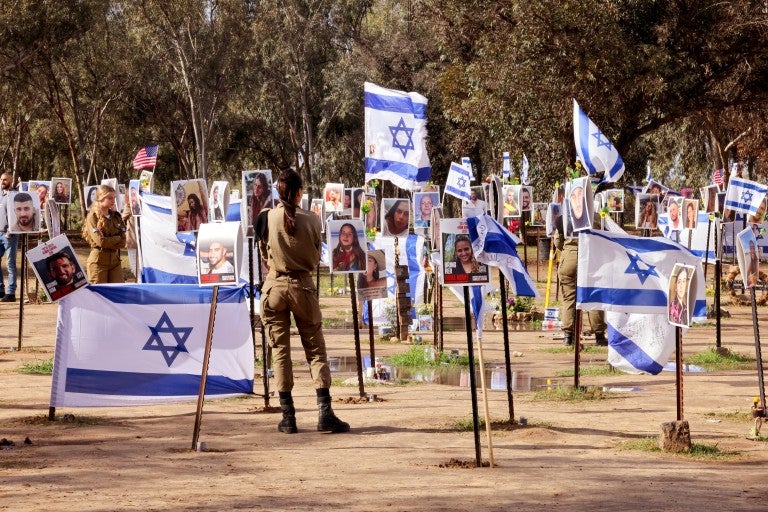May 13, 2023
Following the firing of over 100 rockets from the Gaza Strip on May 2 and the continued terror threats in the West Bank, on May 9, the Israel Defense Forces (IDF) launched Operation Shield and Arrow to neutralize Palestinian Islamic Jihad targets in Gaza. Several hundred rockets have been fired from Gaza toward Israel since the operation began.
In announcing the operation, Israeli Prime Minister Benjamin Netanyahu said that “our principle is clear: Whoever harms us – we will strike at them and with great force. Our long arm will reach every terrorist at a time and place of our choosing.”
Here is what to know about the current situation in the Gaza Strip, the terror organization that controls it, and how Israel defends itself against rocket attacks.
What is Operation Shield and Arrow?
On May 2, Palestinian Islamic Jihad fired 104 rockets and mortars at southern Israel. The operation by the terror group was in response to the death of Palestinian Islamic Jihad security prisoner Khader Adnan, who had been on a three-month hunger strike.
In response to the May 2 rocket fire, the IDF struck a number of terrorist targets in Gaza, including weapon manufacturing sites, military compounds, and underground terror tunnels.
Over a week later, on May 9, the IDF launched Operation Shield and Arrow to target Palestinian Islamic Jihad in Gaza due to their recent rocket fire and deter further action from the terror group. By only targeting Palestinian Islamic Jihad, Israel is making a clear distinction between them and Hamas.
According to the IDF, among the targets that were eliminated were:
- Tarek Az Aldin, who was in charge of coordinating multiple terror attacks against Israelis in the West Bank.
- Jahed Ahnam, who previously served as commander of Islamic Jihad’s southern Gaza division.
- Khalil Bahitini, who was responsible for carrying out all terrorist actions from northern Gaza towards Israel.
“The strikes targeted senior figures responsible for rocket fire from Gaza in recent months and who were involved in organizing additional attacks on Israelis, including in Judea and Samaria,” said IDF spokesperson Brig. Gen. Daniel Hagari, JNS reported.
He added: “Those who endanger Israeli lives, and those who work tirelessly to harm Israel’s security, will not remain unharmed.”
In a call with mayors in southern Israel on May 10, Netanyahu said that Israel is ready to “both expand the current operation and inflict heavy blows on Gaza, now and in the future." Opposition party chairs Yair Lapid and Benny Gantz have both endorsed the security operations in Gaza.
On May 11, the IDF continued targeting senior Palestinian Islamic Jihad leadership. The IDF confirmed that it killed Ali Ghali, the commander of Palestinian Islamic Jihad's rocket launching force, and Ahmed Abu-Deka, deputy commander of the terror organization's rocket force. On May 12, another senior Palestinian Islamic Jihad leader, Iyad al-Hassani, was also confirmed killed. Al-Hassani was a top official in the terror organization's military council and was involved in all decisions concerning rocket fire toward Israel.
Over the five-day conflict, over 1000 rockets were fired towards Israel by Palestinian Islamic Jihad terrorists in Gaza, with the Iron Dome defense system achieving a 91 percent interception rate of projectiles headed toward populated areas. A terrorist rocket strike on the Israeli city of Rehovot tragically killed one Israeli civilian and wounded at least 5 others. The IDF said that approximately 25 percent of Palestinian Islamic Jihad's rockets launched have fallen inside Gaza, wounding multiple civilians. The military says it has carried out strikes against 254 Palestinian Islamic Jihad sites in Gaza, including rocket launching areas and terror tunnels.
How did we get here?
Anti-Israel and antisemitic terrorist organizations located in the Gaza Strip have fired tens of thousands of rockets and mortars at Israeli civilians over the last two decades. The territory has been controlled by the Iran-backed antisemitic terror group Hamas since 2007. Hamas is one of the terror groups that launch rocket attacks on Israel. It also permits other such groups operating in the Gaza Strip, like Palestinian Islamic Jihad, to do the same.
During the May 2021 conflict in Gaza, Hamas and Palestinian Islamic Jihad fired over 4,300 rockets at Israeli civilians. In August 2022, Palestinian Islamic Jihad fired over 1,100 rockets at Israelis during the three-day escalation, according to the Israel Defense Forces.
In April, nearly three dozen rockets were fired from southern Lebanon. The barrage of rockets was the largest such attack from the territory of Israel’s northern neighbor since the 2006 Second Lebanon War. Click here to read more about the connection between Hamas and Hezbollah, as well as rocket attacks from Lebanon.
The violence stemming from Gaza is also linked to increasing terrorism in the West Bank, including Palestinian Islamic Jihad’s efforts to export its knowledge to the West Bank in order to carry out additional terror attacks against Israel. As such, Israeli security forces have been conducting near-daily counterterrorism operations.
Over the past year, Israel has experienced one of its deadliest periods of terrorist violence in Israel since the Second Intifada in the early 2000s. 19 Israelis have been murdered so far this year by Palestinian terrorists – over half the number killed in terror attacks in all of 2022.
Click here to read more about the security situation in Israel and the West Bank.
What is the Gaza Strip?
The Gaza Strip is a 141-square-mile Palestinian enclave located near Israel’s southwestern tip. Bordering Egypt, Israel, and the Mediterranean Sea, the territory is home to over two million Palestinians. Its name is derived from the ancient city of Gaza, the largest city in the territory.
From 1948 to 1967, the Gaza Strip was occupied by Egypt, which took control of the territory during the 1948 Arab-Israeli War, also known as Israel’s War of Independence. As a result of the 1967 Six-Day War, Israel gained control over the Gaza Strip from Egypt.
After Israeli withdrawal in 2005, the territory has been under de jure control of the Palestinian Authority, the governing body of the Palestinians, but de facto control by the Palestinian terrorist organization Hamas, which violently ousted the Fatah-controlled Palestinian Authority from the territory in 2007.
Who is Hamas?
Hamas, or Harakat al Muqawama al Islamiyah, is a Sunni Islamist terrorist organization that operates as the de facto leader of the Gaza Strip. Founded in 1988 during the First Intifada as an offshoot of the Muslim Brotherhood, Hamas set two long-term goals, articulated in its charter: the end of the Jewish state and the creation of an Islamic state from the Jordan River to the Mediterranean Sea. Its more immediate goal is the “liberation of Palestine” and the “return” of the Palestinian people.
While its origins are with the Muslim Brotherhood, Hamas has reportedly been funded, armed, and trained by the Iranian Revolutionary Guard Corps (IRGC) since the early 1990s. Hamas even opened an office in Tehran in the 1990s. Despite its longstanding ties with Tehran, the Palestinian terror group has had a rocky relationship with the Islamic Republic in recent years. In 2012, Iran cut off funding to Hamas after it refused to support the al-Assad regime in the Syrian Civil War.
But Iran resumed financial assistance to Hamas in 2017. “Relations with Iran are excellent, and Iran is the largest supporter of the Izz ad-Din al Qassam Brigades [Hamas’s military wing] with money and arms,” Yahya Sinwar, a senior Hamas military leader, said in 2017. In 2020, the U.S. State Department reported that Iran had provided more than $100 million annually to Hamas and Palestinian Islamic Jihad.
Hamas has used Iranian support to launch several wars against Israel from its base in Gaza, including in 2008, 2009, 2014, and 2021. In each of those attacks, thousands of rockets were fired by terror organizations toward Israeli population centers. In total, dozens of civilians have been murdered via rocket attacks. resulting in dozens of civilian deaths. Hamas has also used Iranian know-how to help build its extensive network of tunnels throughout the Gaza Strip and underneath the Israel-Gaza border to conceal weapons and kidnap Israeli civilians. Hamas continues to develop itself militarily, for instance, launching a commando navy unit that became operational in recent years. Hamas also is currently holding four Israelis in Gaza - the bodies of two Israeli soldiers who were killed in 2014, and two civilians who crossed the border.
Click here to read more about Iran’s support for terror proxies, including Hamas.
Who is Palestinian Islamic Jihad?
Founded in the early 1980s as an offshoot of the Egyptian Muslim Brotherhood, Palestinian Islamic Jihad is the second-largest terrorist group in the Gaza Strip after Hamas. The group has been designated as a terrorist organization by the United States, European Union, the United Kingdom, Canada, Australia, New Zealand, Japan, and Israel.
Like Hamas, Palestinian Islamic Jihad is dedicated to the eradication of Israel and the establishment of an Islamic Palestinian state. According to its “Manifesto of the Islamic Jihad in Palestine,” which was uncovered by U.S. investigators amid the arrest of the group’s North American head Sami al-Arian in 2003, the group rejects any “peaceful solution to the Palestinian cause” and affirms "the Jihad solution and the martyrdom style as the only choice for liberation."
Palestinian Islamic Jihad’s primary sponsor is Iran, which has provided millions of dollars in funding, as well as training and weapons. It also maintains close ties with the Iranian-backed Hezbollah terror group in Lebanon and Hamas.
Click here to read more about Palestinian Islamic Jihad’s role in the August 2022 escalation.
What is Iron Dome and how does it save Israeli and Palestinian lives?
Iron Dome is an air defense missile system operational since 2012 that was developed by two Israeli firms - Rafael Defense Systems and Israel Aerospace Industries - with support from the U.S. Emphasis on defense. It is never used to attack or retaliate and poses no threat to Palestinians.
The strongest air defense system in the world has three components: a radar that detects incoming rockets; a command-and-control system that determines the threat level; and an interceptor that, if the system determines human lives or infrastructure are at risk, seeks to destroy the incoming rocket before it strikes.
According to Israeli officials, it has been about 90% effective in stopping short-range rockets fired by Hezbollah terrorists next door in Lebanon or Hamas and Palestinian Islamic Jihad terrorists in neighboring Gaza. The system protects Israelis of all backgrounds and faiths.
For example, when Hamas and Palestinian Islamic Jihad fired more than 4,300 rockets from Gaza into Israel in May 2021, more than 1,500 targeted heavily populated areas, including Israel’s largest city, Tel Aviv. Iron Dome shot down more than 90% of those rockets, greatly reducing the death toll. Even with Iron Dome, about a dozen Israelis were murdered. That number would have been much higher without the Israeli missile defense system.


